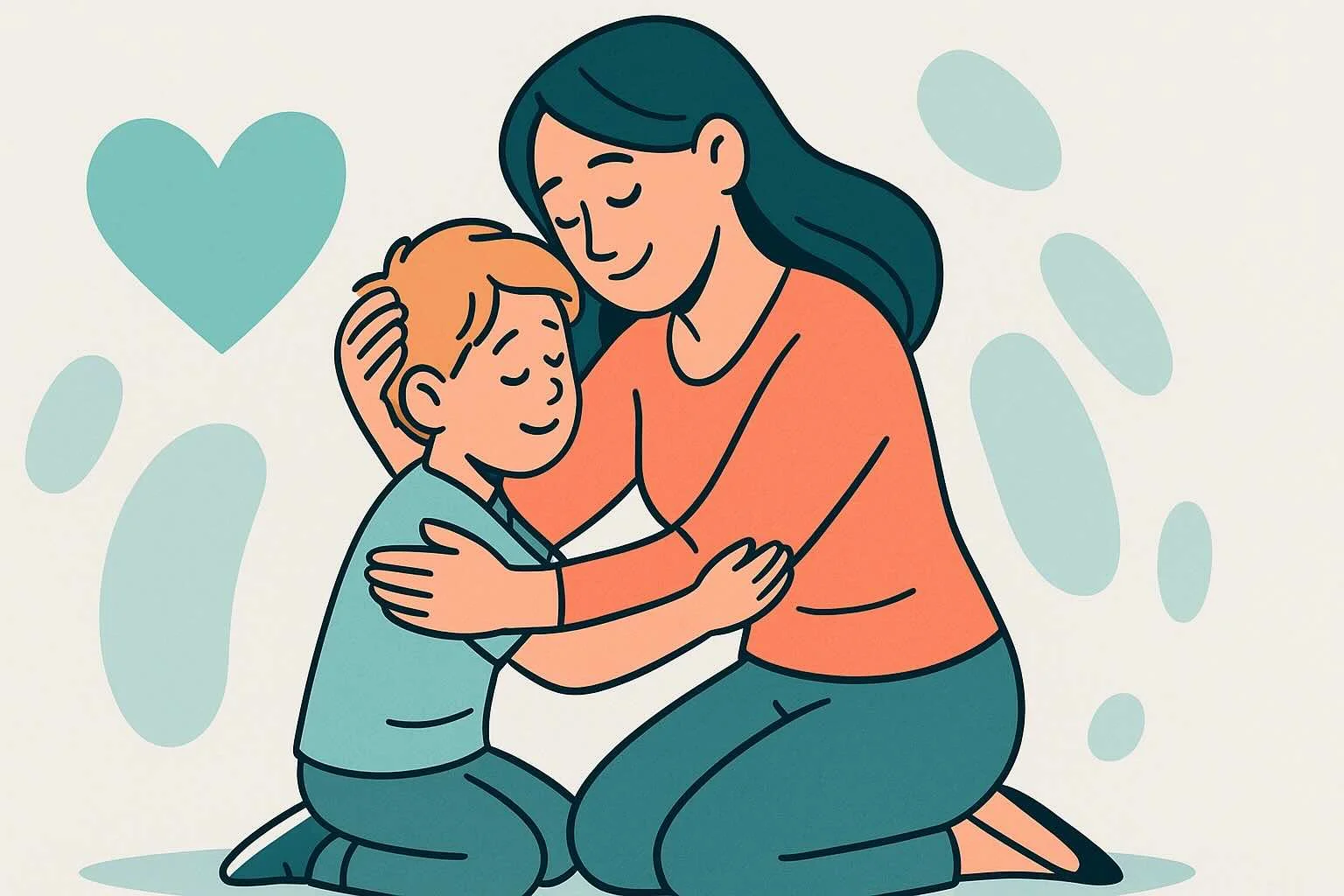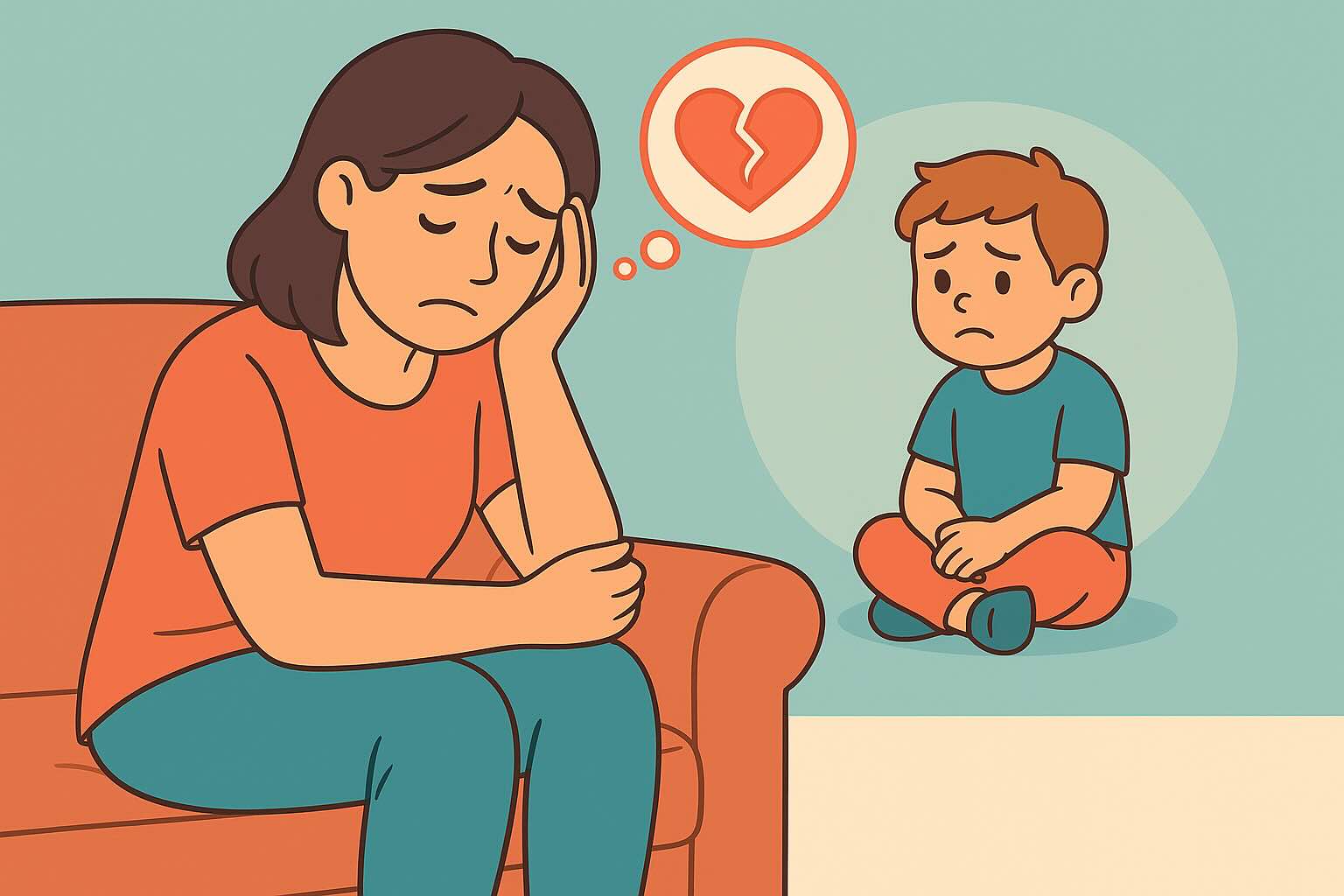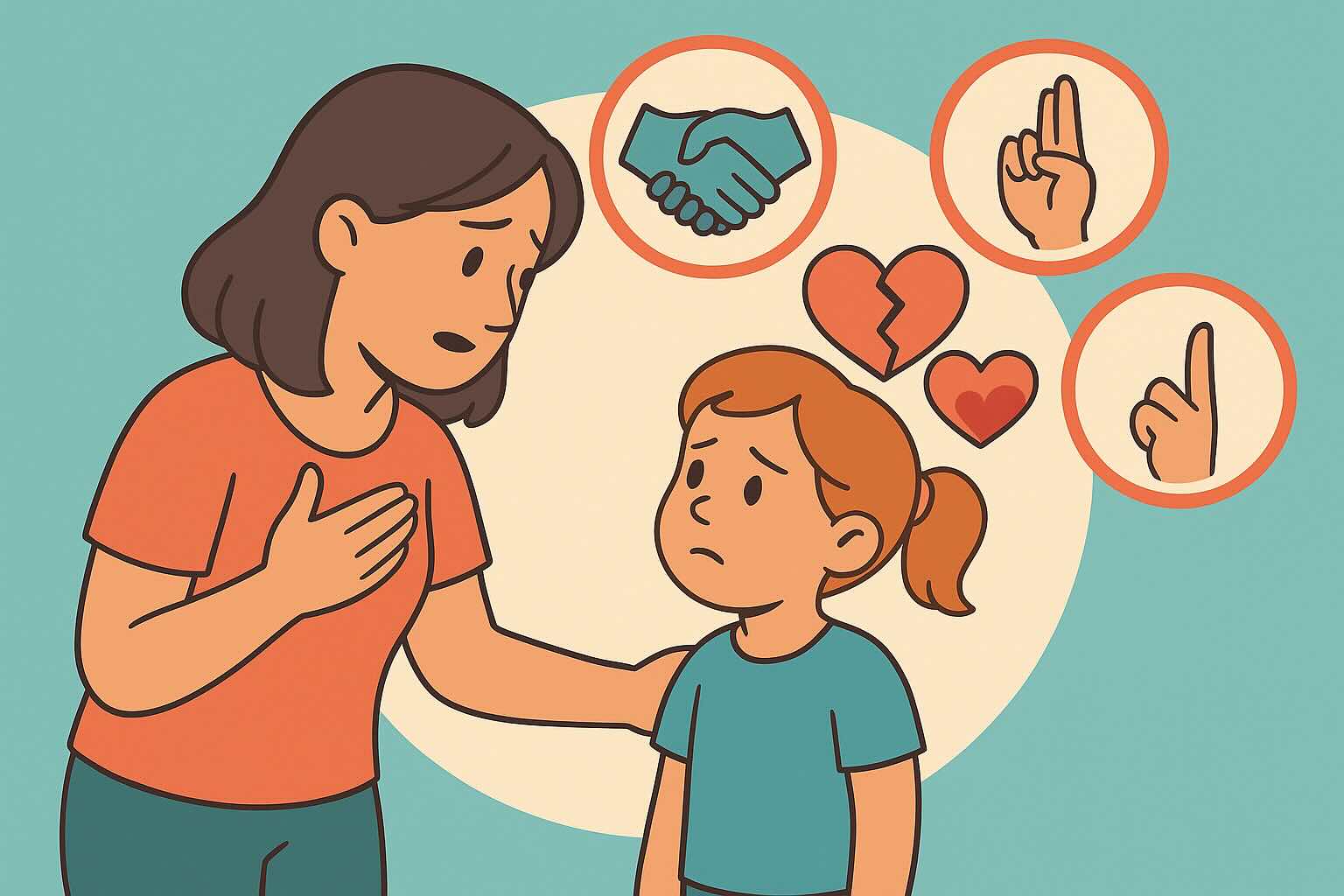Reconnecting After a Big Fight with Your Child

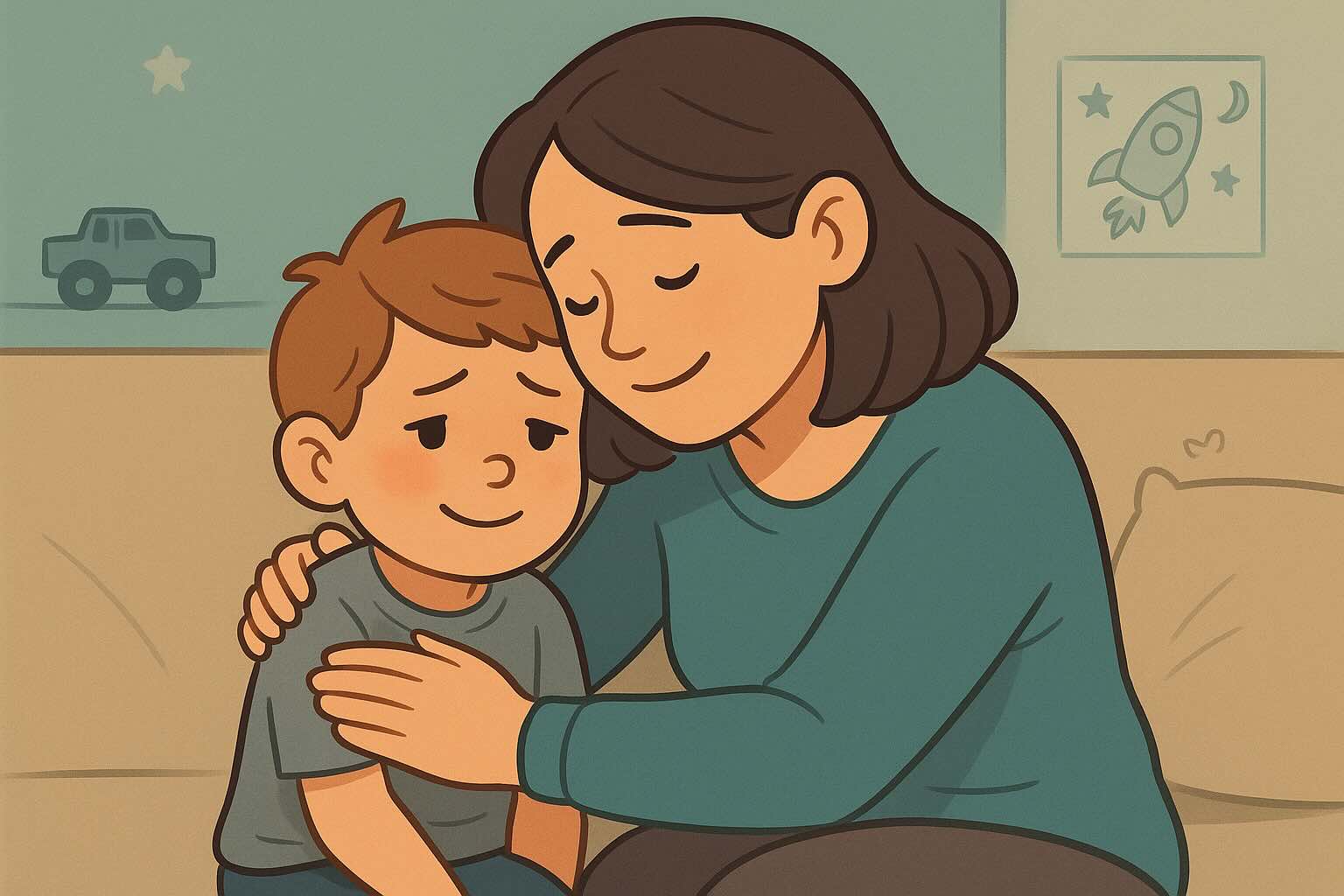
If you're reading this after a conflict with your child that left you both emotionally exhausted, hearts racing, and wondering how things escalated so quickly, know that you're not alone. Research shows that 78% of parents report having at least one "big fight" with their 3-7 year old each month - conflicts that go beyond normal disagreement into emotional overwhelm for both parent and child.
The good news is that these intense moments, while painful, can actually strengthen your relationship when followed by genuine repair and reconnection. Your child is learning that relationships can weather storms, that emotions are manageable, and that love persists through conflict.
For related recovery challenges, also check out our guides on overcoming parent guilt and rebuilding trust after broken promises. You may also find our guides on repairing after losing your cool and recovering from harsh parenting helpful.
What You'll Learn in This Guide
- Understanding Big Fights - What makes a conflict "big" and why they happen with young children
- Immediate Aftermath - What to do in the first hour after a big fight
- The Reconnection Process - Step-by-step strategies to rebuild emotional safety
- Age-Specific Approaches - Different techniques for 3-4 vs 5-7 year olds
- Processing and Learning - How to help your child (and yourself) understand what happened
- Prevention Strategies - Tools to prevent conflicts from escalating to "big fight" level
- Long-term Relationship Healing - Building resilience and conflict skills for the future
Estimated reading time: 11 minutes
Understanding "Big Fights" vs. Normal Conflicts
What Makes a Fight "Big"
Big fights typically involve:
- Emotional overwhelm for parent, child, or both
- Raised voices, yelling, or screaming
- Hurtful words, threats, or character attacks
- Physical reactions (throwing, hitting, slamming doors)
- Fear responses in your child (cowering, hiding, excessive apologizing)
- Feeling like the conflict spiraled out of control
- Either person feeling unsafe emotionally or physically
Normal Conflicts vs. Big Fights
Normal conflicts:
- Disagreement with mostly regulated emotions
- Clear communication about needs or boundaries
- Resolution through compromise or explanation
- Both people feel heard and respected
- Minimal emotional aftermath
Big fights:
- Emotional dysregulation taking over
- Communication breaking down into reactivity
- Escalation rather than resolution
- Fear, hurt, or anger overwhelming the interaction
- Significant emotional aftermath requiring repair
Why Big Fights Happen with Ages 3-7
Developmental factors:
- Limited emotional regulation skills in young children
- Parents feeling triggered by normal childhood behaviors
- Mismatched expectations between adult needs and child capabilities
- Accumulated stress and exhaustion affecting emotional capacity
- Power struggles during developmental independence phases
Common triggers for escalation:
- Time pressure and rushing
- Public embarrassment or judgment
- Repeated requests being ignored
- Challenging behaviors happening at difficult times
- Parent exhaustion, hunger, or overwhelm
Immediate Aftermath: The First Hour After a Big Fight
Step 1: Regulate Yourself First (0-15 minutes)
Before you can help your child, you need to get your own nervous system calm.
Physical regulation:
- Take 10 deep breaths
- Splash cold water on your face
- Do some gentle stretching or movement
- Get a drink of water
- Step outside briefly if possible
Emotional regulation:
- Remind yourself: "We are both safe"
- "This can be repaired"
- "My child is not my enemy"
- "We both lost control and that's human"
- "I can model recovery and repair"
Step 2: Ensure Physical and Emotional Safety (15-30 minutes)
Check on your child:
- Approach slowly and gently
- Get on their physical level
- Use a very soft, calm voice
- Ensure they're not hurt physically or emotionally overwhelmed
Immediate safety language:
- "You are safe with me"
- "I'm sorry that got so big and scary"
- "We both had very big feelings"
- "I love you even when we fight"
Step 3: Allow Processing Time (30-60 minutes)
For your child:
- Let them have whatever emotional response they need
- Don't rush to "fix" their feelings
- Offer comfort if they want it, respect space if they don't
- Continue normal care routines (snack, bathroom, comfort items)
For yourself:
- Resist the urge to justify your behavior immediately
- Don't blame your child for "making you" react
- Process your own emotions before attempting full repair
- Plan your repair approach based on what happened
The Complete Reconnection Process
Phase 1: Initial Reconnection (1-4 hours after)
Your goals:
- Rebuild basic emotional safety
- Acknowledge that something big happened
- Reassure your child that your relationship is secure
- Begin the repair process gently
Age-appropriate approaches:
For ages 3-4: "We had a big fight earlier. That felt scary. You are safe with me. I love you very much. I'm sorry it got so big."
For ages 5-7: "We had a really intense conflict earlier where we both got very upset. I can imagine that felt scary or overwhelming. I want you to know that even when we fight, you are safe with me and I love you. I'd like to talk about what happened when you feel ready."
Phase 2: Full Repair Conversation (4-24 hours after)
Structure your repair conversation:
1. Take responsibility for your part:
- "I yelled at you and that was wrong"
- "I said hurtful things when I was angry"
- "I lost control of my emotions"
- "I made the conflict bigger by getting so upset"
2. Acknowledge their experience:
- "That probably felt very scary when I raised my voice"
- "You might have felt confused or overwhelmed"
- "It wasn't fair to you when I said those things"
- "You were just being a normal kid having big feelings"
3. Validate their emotions:
- "You have every right to feel upset about how I acted"
- "It makes sense that you felt angry/scared/sad"
- "Your feelings about what happened are completely valid"
- "I would feel the same way if someone treated me like that"
4. Share what you learned:
- "I learned that I need to take breaks when I feel overwhelmed"
- "I realized I was feeling stressed about other things and took it out on you"
- "I need to remember that you're still learning how to manage big feelings too"
Age-Specific Reconnection Strategies
Ages 3-4: Simple, Concrete, Comfort-Focused
Young children need simple explanations and lots of reassurance that they're safe and loved.
Key principles:
- Use very simple language about what happened
- Focus on safety and love rather than complex explanations
- Offer physical comfort and presence
- Be prepared to repeat reassurances multiple times
- Use concrete actions to show love and safety
Effective reconnection approach: "Earlier we both got very upset and had big feelings. That felt scary. You are safe with Mommy/Daddy. I love you so much. Even when we fight, I always love you. Let's do something gentle together."
Reconnection activities for ages 3-4:
- Reading a favorite book together
- Gentle snuggling or rocking
- Drawing or coloring side by side
- Playing with soft toys or comfort items
- Singing quiet songs together
- Taking a warm bath with bubbles
Ages 5-7: Understanding, Processing, Problem-Solving
Children this age can understand more about emotions and relationships, and benefit from processing what happened.
Key principles:
- Acknowledge their emotional experience specifically
- Help them understand that fights don't mean loss of love
- Involve them in understanding what went wrong
- Problem-solve together for future conflicts
- Validate their right to feel upset about how you acted
Effective reconnection approach: "I want to talk about our big fight earlier. I can see it was upsetting for you, and I take responsibility for how I handled my emotions. Let's figure out together how we can handle big feelings better next time."
Processing questions for ages 5-7:
- "What felt the scariest part for you?"
- "What do you wish had happened differently?"
- "How were you feeling when the fight started?"
- "What would help you feel safer when we disagree?"
- "What should we do when we both start getting really upset?"
Specific Repair Scripts for Common Big Fight Scenarios
After Yelling Match/Escalated Volume
For ages 3-4: "We both used very, very loud voices earlier. That felt scary and overwhelming. Loud voices can hurt our feelings even though they don't hurt our bodies. I should have used my calm voice even when I felt upset. You are safe with me."
For ages 5-7: "We got into a yelling match earlier where we both escalated our voices. I can imagine that felt chaotic and maybe scary. I was wrong to raise my voice like that - even when I'm frustrated, I should model calm communication. You deserved better from me in that moment."
After Hurtful Words Were Exchanged
For ages 3-4: "We said mean words to each other when we were angry. Mean words hurt feelings. I said things that weren't kind or true. You are a good kid and I love you. I'm sorry for the mean words."
For ages 5-7: "We both said some hurtful things to each other when we were angry. I said things that weren't fair or kind, and I imagine my words felt really hurtful. When I'm upset, I should still speak to you with respect. I'm sorry for the things I said that hurt your feelings."
After Threats or Ultimatums
For ages 3-4: "I said something scary about [specific threat] when I was angry. That was wrong. I don't mean those scary things. You are safe with me and I would never really [do threatened action]."
For ages 5-7: "I made threats about [specific threats] when I was angry, and that was wrong. I was trying to control your behavior through fear, and that's not how I want to parent. Those threats weren't fair or realistic, and I understand if they felt scary or confusing."
After Physical Reactions (Throwing, Slamming, etc.)
For ages 3-4: "I threw/slammed [object] when I was angry. That was scary and not safe. When people are angry, we need to keep everyone safe. I will be more careful with my body when I feel upset."
For ages 5-7: "I lost control of my physical reactions when I was angry and threw/slammed [object]. That probably felt scary and chaotic. Even when I'm very upset, I need to keep my body safe and calm. That kind of reaction isn't okay, and I'm working on better ways to handle intense anger."
Reconnection Activities by Age
Ages 3-4: Comfort and Safety Focus
Immediate reconnection activities:
- Reading gentle books about feelings or conflict resolution
- Playing with soft, comforting toys together
- Drawing pictures of happy times together
- Having a special snack or drink together
- Building something simple with blocks
- Gentle physical activities like rolling a ball back and forth
Safety-building rituals:
- Creating a "love you" song to sing together
- Making a photo book of happy family times
- Establishing a special bedtime routine after conflicts
- Creating comfort rituals for when either person feels upset
Ages 5-7: Understanding and Problem-Solving
Processing and reconnection activities:
- Drawing pictures of the conflict and how they felt
- Writing or dictating stories about families working through problems
- Role-playing better ways to handle the same situation
- Creating family rules for conflicts together
- Making plans for future challenging situations
Collaborative problem-solving:
- "What should our family do when someone starts getting really upset?"
- "How can we help each other stay calm during disagreements?"
- "What code word should we use when conflicts are getting too big?"
- "What helps you feel better after we've had a fight?"
Processing Emotions and Learning Together
Helping Your Child Process Their Emotions
For ages 3-4:
- Use simple feeling words: "You felt scared, angry, sad"
- Validate emotions: "It's okay to feel upset when people fight"
- Offer comfort: "Would you like a hug? Or space?"
- Read books about emotions and conflicts
- Use play to process (dolls having conflicts and making up)
For ages 5-7:
- Help them identify specific emotions: "What were you feeling when...?"
- Discuss the physical sensations of emotions: "Where did you feel that in your body?"
- Explore thoughts: "What were you thinking when...?"
- Problem-solve: "What could help you feel better next time this happens?"
- Validate their experience: "That sounds really overwhelming"
Teaching Conflict Skills for the Future
Age-appropriate conflict skills:
Ages 3-4:
- Using words for feelings: "I'm mad," "I'm sad," "I need help"
- Taking breaks: "I need space" or going to calm-down corner
- Asking for help: "Can you help me?" when overwhelmed
- Simple problem-solving: "Let's try this way"
Ages 5-7:
- Identifying escalation signs: "I'm starting to feel really upset"
- Requesting breaks: "I need a few minutes to calm down"
- Expressing needs clearly: "I need you to listen to me"
- Collaborative problem-solving: "Let's figure this out together"
- Conflict repair: "I'm sorry I said that. Can we try again?"
Prevention: Reducing Big Fight Frequency
Understanding Your Family's Conflict Patterns
Common escalation patterns:
- Rushing + child's normal pace = parent frustration
- Child's big emotions + parent's overwhelm = mutual dysregulation
- Repeated requests + child's developmental limitations = power struggle
- Parent stress + normal childhood behavior = overreaction
Track your triggers:
- What times of day do big fights happen most?
- What situations tend to escalate quickly?
- What are your personal stress factors that affect your patience?
- What developmental challenges is your child currently facing?
Environmental Prevention Strategies
Reduce conflict-prone situations:
- Build in more time for transitions
- Prepare for challenging activities with clear expectations
- Address basic needs (hunger, tiredness) proactively
- Create calm-down spaces for both you and your child
- Establish clear routines to reduce daily friction
Early intervention techniques:
- Notice your own early warning signs of frustration
- Teach your child to recognize their escalation signs
- Create family signals for when someone needs a break
- Practice calming techniques during peaceful moments
- Establish clear protocols for when conflicts begin
Building Family Emotional Regulation Skills
Daily practices:
- Morning emotional check-ins for family members
- Evening reflection on challenging and successful moments
- Regular practice of calming techniques
- Reading books about emotions and conflict resolution
- Celebrating successful conflict resolution
Family conflict agreements (for ages 5-7):
- "In our family, we take breaks when emotions get too big"
- "We use respectful words even when we're upset"
- "We work together to solve problems"
- "We repair when we make mistakes in conflicts"
- "Everyone's feelings are important and valid"
Long-term Relationship Healing and Growth
Building Conflict Resilience
After successful repair from big fights, your child learns:
- Relationships can survive intense conflicts
- Emotions are temporary and manageable
- People can change their behavior and apologize meaningfully
- Love persists through disagreement and difficulty
- Problems can be solved collaboratively
You model important life skills:
- How to take responsibility for mistakes
- How to repair relationships after hurt
- How to manage intense emotions constructively
- How to problem-solve rather than blame
- How to maintain connection through conflict
Creating a Family Culture of Repair
Regular family practices:
- Weekly family meetings to discuss what's working and what isn't
- Celebration of successful conflict resolution
- Openness about mistakes and learning
- Regular emotional check-ins and support
- Problem-solving challenging situations together
Teaching repair skills to your child:
- Model saying "I'm sorry" meaningfully
- Show them how to check on someone after conflict
- Teach them to ask "What do you need to feel better?"
- Practice collaborative problem-solving during calm moments
- Celebrate when they repair relationships with siblings or friends
Your 3-Week Conflict Recovery and Prevention Plan
Week 1: Focus on Repair and Safety
- Complete full repair process for the recent big fight
- Prioritize emotional safety and connection
- Avoid new conflicts by reducing demands and expectations
- Practice staying calm during normal childhood challenging behaviors
Week 2: Skill Building and Understanding
- Help your child process their emotions about the conflict
- Identify family triggers and patterns together
- Begin teaching age-appropriate conflict skills
- Create family agreements about handling big emotions
Week 3: Prevention and Practice
- Implement environmental changes to reduce conflict triggers
- Practice new conflict skills during small disagreements
- Establish regular emotional check-ins and support systems
- Plan specific strategies for challenging situations
When to Seek Professional Support
Concerning Patterns
Consider professional help if:
- Big fights happen multiple times per week
- Conflicts are becoming more intense or frequent over time
- Your child shows signs of anxiety, depression, or trauma responses
- You feel unable to control your anger even with awareness
- Family functioning is significantly impacted by conflict patterns
- Other family members are being affected by the conflict intensity
Types of Support Available
Family therapy helps improve communication and conflict resolution skills Parent coaching provides specific strategies for managing challenging behaviors Individual therapy addresses personal triggers and emotional regulation Support groups offer connection with other parents facing similar challenges
Key Takeaways: Your Conflict Recovery Roadmap
- ✅ Big fights can strengthen relationships when followed by genuine repair
- ✅ Immediate emotional safety is the first priority after intense conflict
- ✅ Age-appropriate repair helps children process and understand what happened
- ✅ Full responsibility for your part models accountability and growth
- ✅ Processing emotions together builds family emotional intelligence
- ✅ Prevention strategies reduce the frequency of intense conflicts
- ✅ Conflict skills can be taught and practiced during calm moments
- ✅ Professional support is available when patterns become concerning
- ✅ Family resilience grows through successful conflict resolution
Remember: The goal isn't to never have conflicts, but to handle them in ways that preserve emotional safety and teach valuable relationship skills.
This article is based on attachment theory, emotion regulation research, and family therapy practices. Every family has different conflict patterns and recovery needs. Trust your instincts about your child's emotional safety and seek professional support when needed.
Challenging Moments Support
Access step-by-step parenting strategies, quick tips, and age-specific guidance for difficult situations when you need it most.
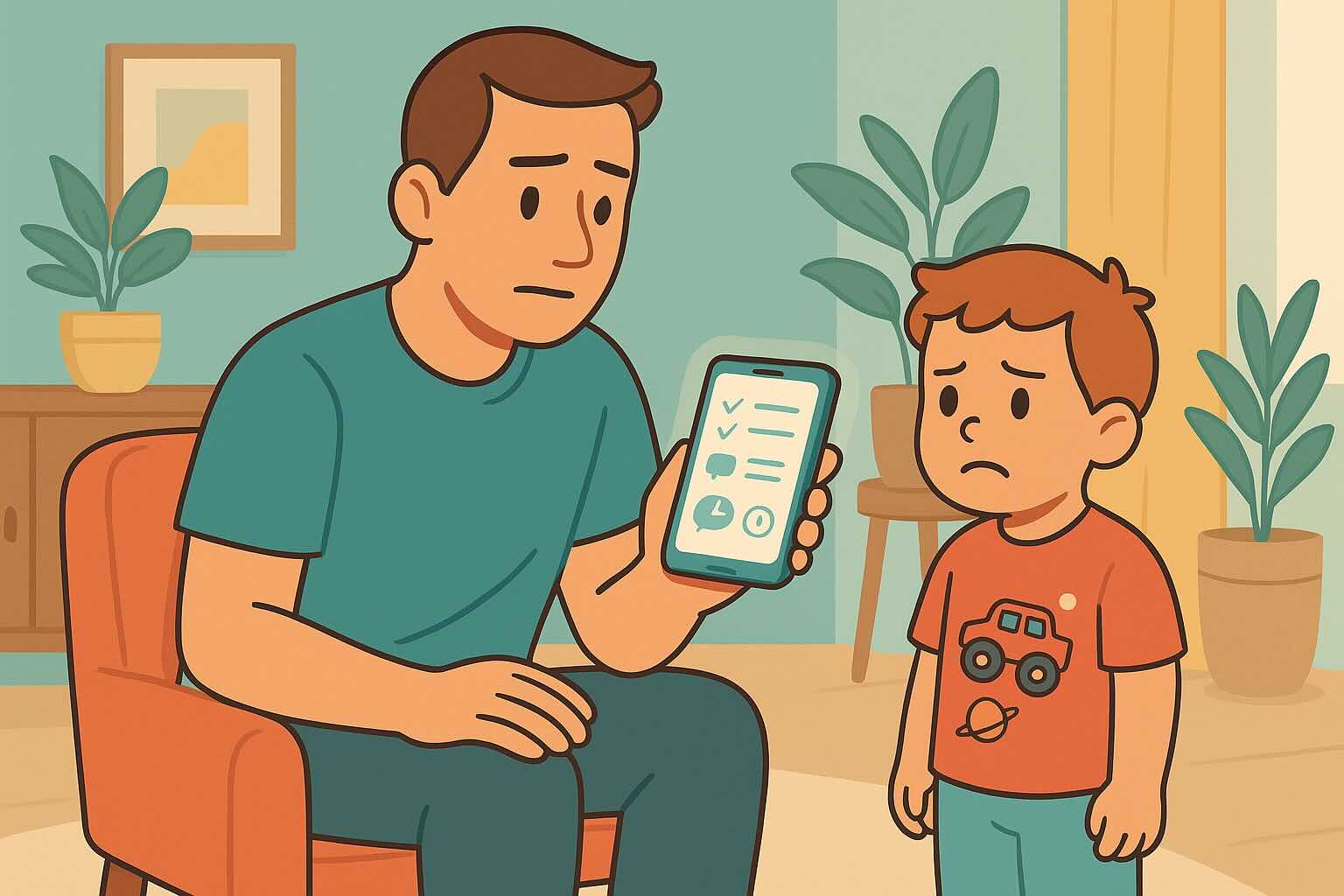
Parent Repair Scripts
Word-for-word scripts for rebuilding trust and modeling accountability after losing your cool with your child.
Frequently Asked Questions
Need personalized support?
RootWise's AI coach can provide tailored strategies for your specific situation, available 24/7 when you need it most.
Learn More About AI Coaching →